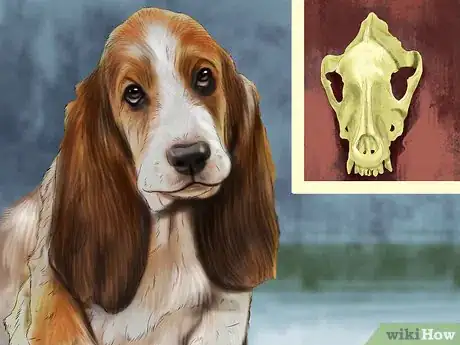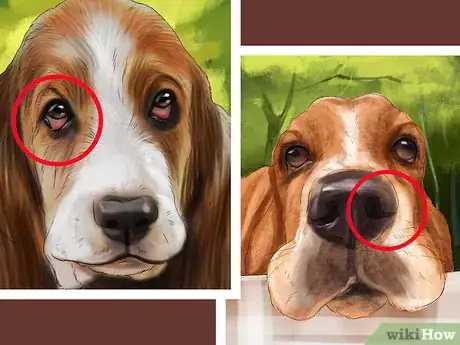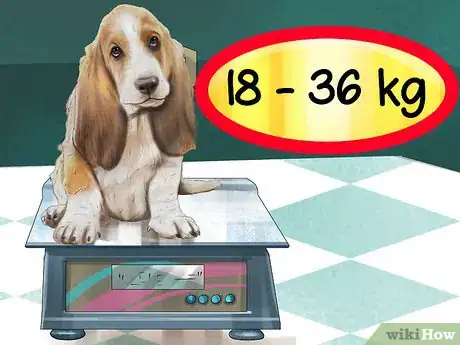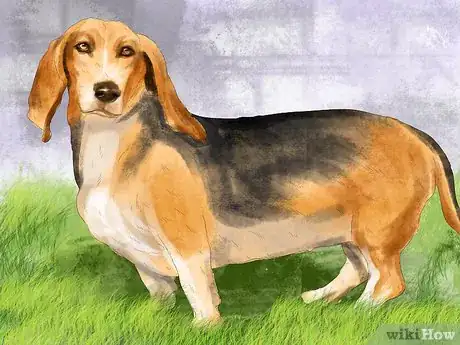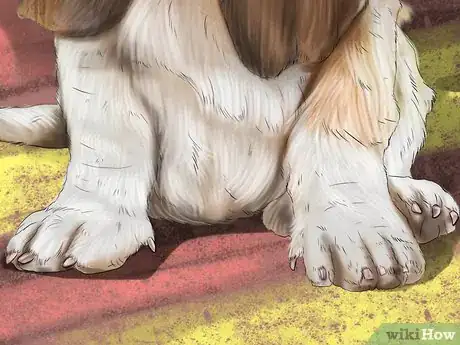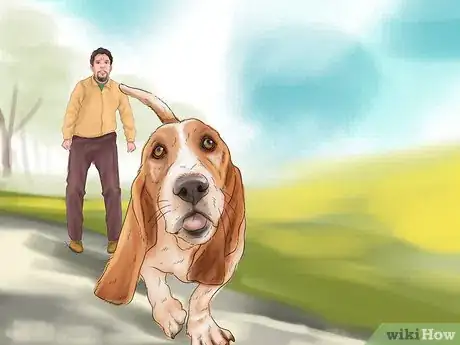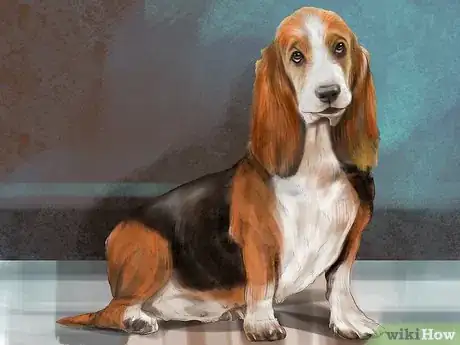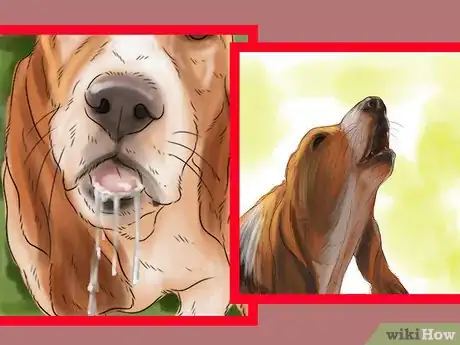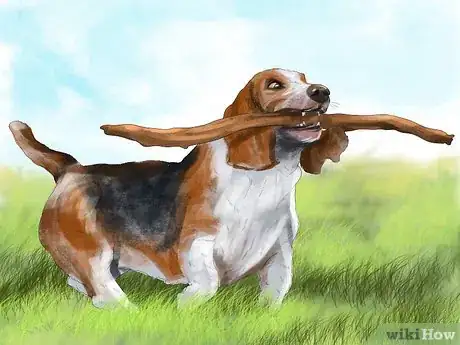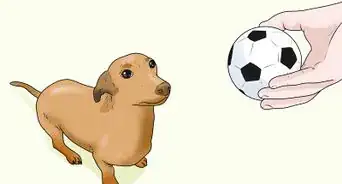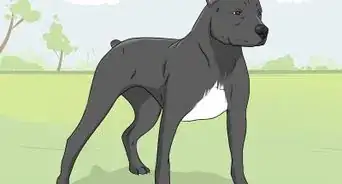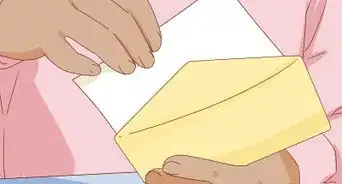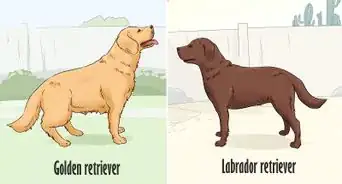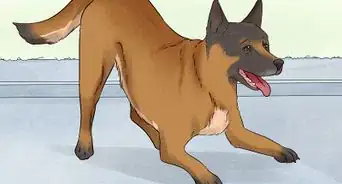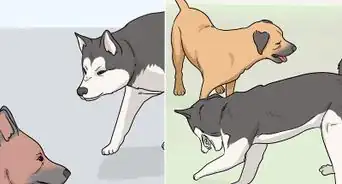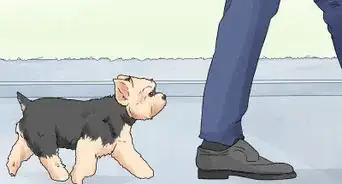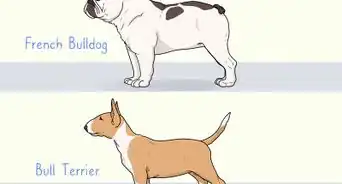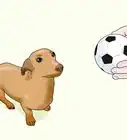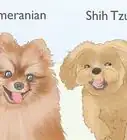This article was co-authored by Deanne Pawlisch, CVT, MA. Deanne Pawlisch is a Certified Veterinary Technician, who does corporate training for veterinary practices and has taught at the NAVTA-approved Veterinary Assistant Program at the Harper College in Illinois and in 2011 was elected to the board of the Veterinary Emergency and Critical Care Foundation. Deanne has been a Board Member of the Veterinary Emergency and Critical Care Foundation in San Antonio, Texas since 2011. She holds a BS in Anthropology from Loyola University and an MA in Anthropology from Northern Illinois University.
This article has been viewed 23,654 times.
Basset Hounds are an aptly named breed of dog that are known, at least in part, for their close proximity to the ground. In fact, “basset” translates to “rather low” in French, reflecting their short legs relative to their body size. In general, they are laid-back dogs that are entirely comfortable lounging around or plodding through the fields and surveying the land with their prominent snouts and noticeable ears. Known for a calm, independent demeanor, they are stubbornly defiant to training but unquestionably loyal.[1]
Steps
Recognizing a Basset Hound’s Head and Face
-
1Examine their large, low-hanging ears. Basset Hounds' ears are perhaps their most recognizable physical feature. They are very large and long enough to nearly touch the ground when the dog is tracing a scent. The size helps these large ears serve a purpose: they effectively sweep scent forward towards the dog's nose.[2]
- If your gently draw an ear forward, it will easily fold over the front of a Basset Hound's nose. Their ears will also be velvety to the touch.
- Since the ears are set very low on a Basset Hound's head, they may look as though they are growing out of the dog's neck, especially when the dog is sitting down.
- Even as puppies, Basset Hounds will have very large ears. This feature is so prominent that it can help identify a Basset Hound puppy without seeing the dog's parents.
-
2Note the shape of the dog’s skull. The head of a Basset Hound is larger and well-proportioned to its shoulders and body. Its skull will be longer than it is wide. Most Basset Hound skulls will have a visible dome and noticeable bump on the back. The muzzle will be about equal in length to the rest of the skull.[3]
- When you look at the dog’s head from the side, the top of the skull and the muzzle will both be flat and on parallel planes.
Advertisement -
3Look for telling facial characteristics. Basset Hound noses are darkly colored, and they have wide nostrils that seem to be held open. The lips are also darkly colored, and hang heavily from the dog’s mouth. Overbites and underbites are relatively uncommon in this breed. A Basset Hound’s sunken brown eyes are also especially recognizable, and will likely strike you as soft and sad.[4]
-
4Note the tension of the dog’s skin. Basset Hounds have heavy, loose, and elastic skin, especially on their heads. Watch when the dog lowers its head to the ground; distinct wrinkles will show above its eyes. The dewlap, or the flap of skin hanging lengthwise beneath the dog’s head and neck, will be very prominent.[5]
Observing a Basset Hound's Body
-
1Recognize a Basset Hound’s standard size. While adult Basset Hounds range in size from as little as 40 to as many as 80 pounds (18-36 kg), they are all rather short. Their backs are also relatively long for their height, with their shoulder reaching only 15 inches (38 cm) or so. Accordingly, a Basset Hound will always appear much longer than it is tall.[6]
-
2Look for a prominent chest. A Basset Hound’s sternum will push through its front legs enough to be visible from the side of the dog. The chest will also be quite deep, meaning it extends towards the ground noticeably. Shoulders are powerful looking and located on the side of the dog’s body.[7]
-
3Feel the dog’s legs. Both the front and back legs of a basset hound will feel strong to the touch, despite being humorously short and covered in noticeably loose skin. The paws of Basset Hounds are quite large, and feature tough, prominent padding. The feet may also splay out to the sides a bit.[8]
-
4Watch the dog walk. A Basset Hound’s gait reflects their appearance and demeanor. They move casually and with apparent heaviness, yet seemingly without effort. They will often hold their noses low to the ground. Elbows will be tucked against the dog’s body. Their powerful plodding may even warrant a chuckle from time to time.[9]
-
5Expect a range of coat colors. There’s no color code or markings that necessarily indicate a dog is a Basset Hound. Most feature two or three colors, often including white or black. Tan, brown, or red areas are also common. Often, the colors of the coat on the back, head, and shoulders will be different from the color of the chest and underbelly.
Assessing a Basset Hound’s Temperament
-
1Observe the dog’s personality. Basset Hounds are notorious for being pleasant and laid back. While some act regal from time to time, most would make a better jester. Whatever their personality, they are reliably peaceful, and are quicker than many breeds to wag their tails. That said, they also have a stubborn streak when it comes to training.[10]
- In particular, these dogs are less keen to “come back” than many others. If you take a Basset Hound outside, make sure they are in a fenced in area or on a leash at all times.
-
2Know what to expect. Every breed of dog has some characteristics that are not ideal. If you’re considering getting a Basset Hound, make sure none of their classic characteristics are too prevalent for you to put up with. Foremost, anticipate an independent, slow-to-listen attitude that will prolong training, including housebreaking. [11]
- Expect plenty of slobbering and drooling, not to mention audible snoring and a good deal of shedding.
- You’ll hear a fair amount of baying and howling, especially when the dog is bored.
- Finally, be aware that you’ll smell them - both the odor of their coats and their gassy digestion is well renowned. You cannot wash this smell away, as Basset Hounds have oily coats.
- You will also need to brush the dog daily because it will constantly shed.
- Basset Hounds can have a number of health issues, including limitations caused by their build. They should always be discouraged from jumping and, as they age, will likely struggle on the stairs.
-
3Look for Basset Hounds' positive traits. From the perspective of a dog owner (prospective or otherwise), Basset Hounds have a few characteristics you may be looking for. They are a strong, good-sized breed of dog, and they are also very friendly.[12]
- They are one of the most friendly breeds, and get along with people, other dogs, and even cats. If these are traits you’re looking for, a Basset Hound may be right for you.
- You can take your Basset Hound on walks, but their short legs are not well-suited for jogging.
References
- ↑ http://dogtime.com/dog-breeds/basset-hound#/slide/1
- ↑ http://images.akc.org/pdf/breeds/standards/BassetHound.pdf?_ga=1.41548330.903239952.1480363038
- ↑ http://images.akc.org/pdf/breeds/standards/BassetHound.pdf?_ga=1.41548330.903239952.1480363038
- ↑ http://images.akc.org/pdf/breeds/standards/BassetHound.pdf?_ga=1.41548330.903239952.1480363038
- ↑ http://images.akc.org/pdf/breeds/standards/BassetHound.pdf?_ga=1.41548330.903239952.1480363038
- ↑ http://www.just-basset-hounds.com/basset-hound-breed.html
- ↑ http://images.akc.org/pdf/breeds/standards/BassetHound.pdf?_ga=1.41548330.903239952.1480363038
- ↑ http://images.akc.org/pdf/breeds/standards/BassetHound.pdf?_ga=1.41548330.903239952.1480363038
- ↑ http://images.akc.org/pdf/breeds/standards/BassetHound.pdf?_ga=1.41548330.903239952.1480363038
About This Article
To identify a Basset Hound, look for large, low-hanging ears that almost touch the ground. You'll also notice loose skin, a deep chest, and short legs. When assessing the dog’s temperament, look for a dog that's pleasant, laid back, and friendly. If you’re thinking about adopting a Basset Hound, make sure you’re prepared to work with an independent, slow-to-listen dog that may take longer to train. Additionally, keep in mind that Basset Hounds are prone to drooling, howling, and shedding. For more tips from our Veterinary co-author, including how to recognize a Basset Hound by its walk, keep reading!

